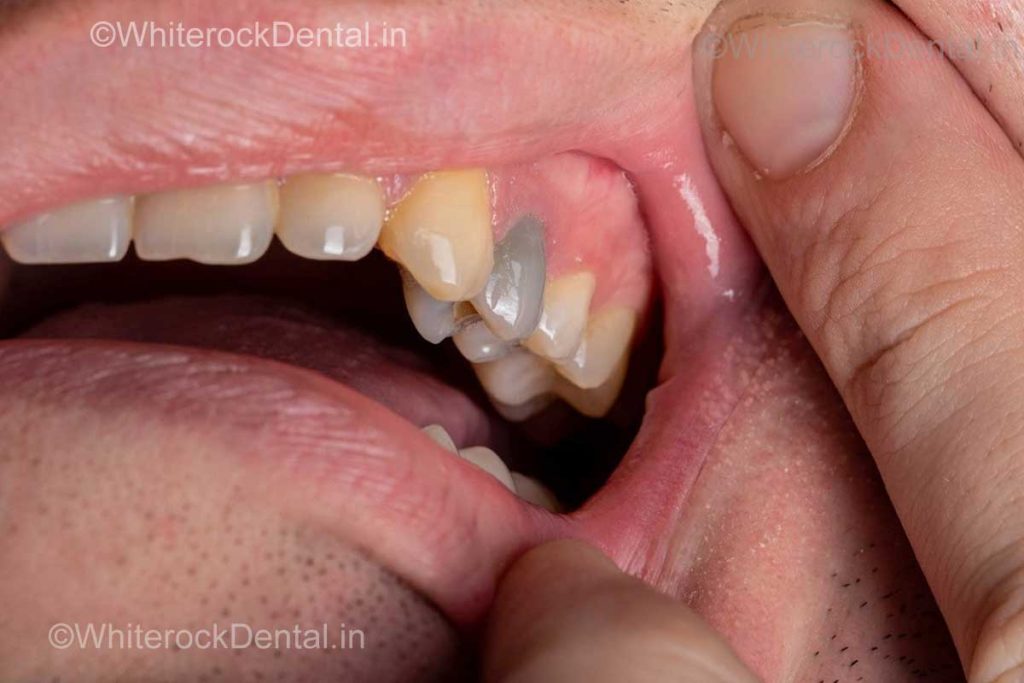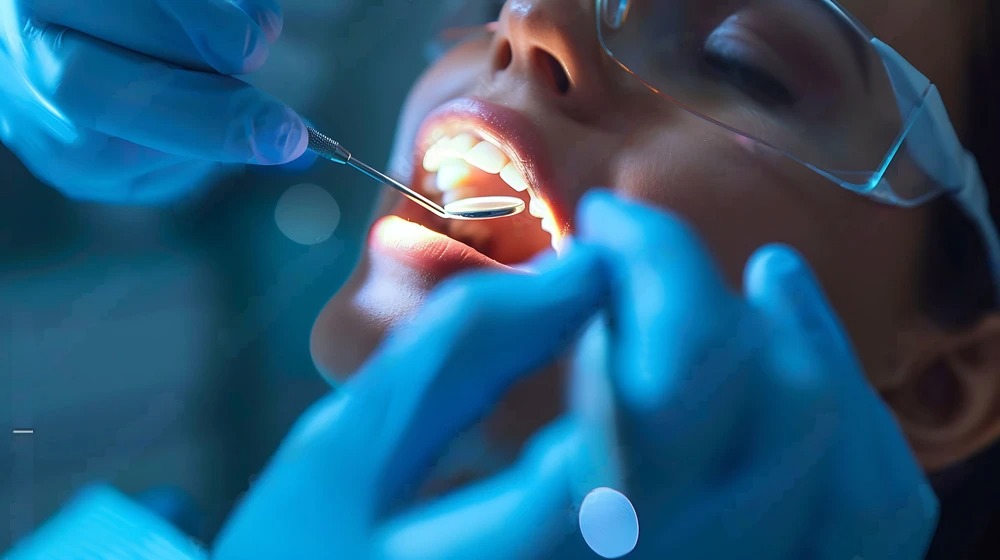
Darkened Tooth Color: When to Seek Help
-By Dr Pauravi Hegde MDS
Hello, everyone! I’m Dr Pauravi Hegde MDS, a long-time dentist practicing in Mumbai and specializing in helping folks keep their smiles bright and healthy. One issue I’ve seen come up time and again—especially from patients around Sion, Chembur, Prabhadevi, Worli, King’s Circle, and Chunabhatti—is tooth discoloration. Most people fret about a yellowish tint on their teeth because of tea or coffee stains. But what truly raises alarms is when a single tooth (or a specific area on it) goes dark, turning grayish, brownish, or even blackish. That often prompts the question: “Is this something serious?”
In this article, we’ll walk you through the possible causes of a tooth darkening, the signs that mean you might need to see a dentist ASAP, and how to prevent future discoloration. It’s not always just a cosmetic concern—sometimes, that dark shade can point to deeper dental issues. Let’s dive in!
1. Introduction
Why Focus on Tooth Color?
Many patients come to me saying, “Dr Pauravi Hegde MDS, I think my tooth is dying—should I be worried?” Or they’ll show me a front tooth that’s turned noticeably darker than the others. Tooth discoloration, especially when it’s just one tooth, can be a big red flag. It can signal trauma, underlying infection, or even past dental work that’s no longer serving you well.
That said, not all darkening is cause for panic. Sometimes, it’s just a stain on the surface from foods like paan or drinks like cutting chai. The challenge is knowing the difference and acting before something small turns major. So, let’s clarify what tooth discoloration means and why it matters—whether you live in bustling Worli or cozy Chembur.
2. Understanding Tooth Discoloration
Different Types of Discoloration
Extrinsic (Surface) Stains
- These happen outside the tooth—think of it like a stain on your white T-shirt. Common culprits include coffee, tea, red wine, or tobacco. If you love indulging in local street foods loaded with turmeric or masala, those spices can also leave surface stains.
- Good news: A professional cleaning session or whitening treatment can often tackle these stains effectively.
Intrinsic (Internal) Stains
- This is when the discoloration originates inside the tooth. It can be due to nerve damage, trauma, or certain medications.
- Intrinsic stains are usually more stubborn. If your pulp (the tooth’s nerve) is infected or has died, you might see a dull gray or dark color that no normal whitening can fix.
Age-Related Changes
- Over time, our enamel (the tooth’s outer layer) wears down, revealing more of the dentin beneath, which is naturally more yellowish. This can be a gradual shift and usually affects multiple teeth.
Local Eating Habits and Their Impact
If you’re from King’s Circle and rely on chai breaks daily or from Chunabhatti where you enjoy spicy roadside snacks, you might notice more superficial yellowing or brownish stains. But a single dark tooth among others is often not from these habits alone—there might be more going on beneath the surface.
Why One Tooth Might Darken
Imagine you have a row of teeth, all slightly off-white, and suddenly, one of them becomes noticeably darker. Often, it’s a sign of an intrinsic problem—like pulp death or deep decay. Sometimes, old fillings or crowns can also cause localized discoloration if the margins leak or the material ages poorly.
3. Common Causes of a Darkened Tooth
1. Trauma or Injury
- Accidents Happen: A fall or bump during a friendly cricket match in your building’s compound can shock the tooth’s nerve.
- When the nerve gets traumatized, it may die over time, leaving the tooth looking dull or grayish.
- This can happen even if the incident was months or years ago—a slow, internal process can lead to discoloration much later.
Anecdote: I treated a patient from Prabhadevi who complained about a front tooth turning grayish. Turns out, she fell off her bicycle as a teen, never had any immediate pain, but years later, that tooth started to darken. A simple test revealed the nerve had died from the old trauma. We did a root canal and then internal bleaching to restore her bright smile.
2. Deep Decay or Infection
- Untreated Cavities: If you’ve had a cavity for a while and avoided the dentist (maybe due to hectic Mumbai commutes?), it could progress until the nerve is infected or necrotic.
- Symptoms: Sometimes you get sensitivity or pain, but not always. The tooth might just darken, indicating pulp damage.
3. Failed or Aging Dental Work
- Old Silver Fillings (amalgams) can cause a grayish hue to the surrounding tooth structure.
- A previous root canal that wasn’t sealed properly or has re-infection might lead to further discoloration.
- Leaking fillings or crowns can let bacteria in, also affecting the tooth color internally.
4. Certain Medications or Fluorosis
- Tetracycline stains appear as bands or stripes if the drug was used during tooth development.
- Excessive fluoride (fluorosis) can cause chalky white spots or even brownish discoloration.
- This type of staining usually affects multiple teeth, so if it’s just one tooth going dark, it might be due to other reasons.
4. Warning Signs: When to Seek Help
1. Persistent Toothache or Sensitivity
- A dull ache or acute pain that lingers can signal nerve damage.
- If darkening is paired with throbbing pain—especially after hot or cold foods—don’t ignore it! The nerve may be inflamed or infected.
2. Sudden Color Shift After Injury
- If you had a recent mishap—like biting hard on a seed while eating bhel puri—keep an eye on that tooth.
- A graying tooth weeks or months after an injury suggests internal bleeding or pulp death.
3. Swelling, Gum Tenderness, or Abscess
- If the gum around the tooth looks swollen or you spot a small “pimple” (abscess), that’s a sign of infection that’s likely reached the root.
- Prompt treatment can prevent a full-blown abscess or bone loss.
4. Dark Spots That Spread
- A small shadow on the tooth that gradually expands could mean active decay.
- If you live in Sion or Chembur and commute daily, you might delay appointments. But the longer you wait, the bigger the problem gets—potentially leading to a root canal or extraction.
5. Diagnostic Steps a Dentist May Take
1. Visual Exam and Dental History
Upon your visit, I—Dr Pauravi Hegde MDS—would take a thorough look at your tooth, gums, and overall mouth. We’d chat about:
- Your habits (any teeth grinding, tobacco use?).
- Recent injuries or surgeries.
- Dietary preferences (excess chai, coffee, or aerated drinks?).
2. X-Rays or Digital Imaging
- Digital X-rays reveal hidden decay, infections near the bone, or old restorations failing under the surface.
- This step is crucial to confirming if the tooth’s nerve is compromised.
3. Pulp Vitality Tests
- We apply a cold or electric stimulus to check if the tooth’s nerve is responsive. A healthy nerve typically reacts quickly and recovers.
- A “dead” or dying pulp might not respond at all or cause prolonged, painful sensitivity.
4. Shade Analysis
- For purely cosmetic concerns (like a dark front tooth with healthy nerve), we measure the tooth’s color using shade guides.
- This helps in planning treatments like bleaching or veneers to match your other teeth.
6. Treatment Options: From Simple Fixes to Complex Solutions
1. Professional Cleaning or Polishing
- If your darkened tooth is extrinsic (surface stains) from coffee or paan, a scaling and polishing session might fix it.
- Many patients in Worli or Chunabhatti who love their morning tea are surprised at how a single cleaning session can drastically improve their tooth shade.
2. Internal Bleaching
- If your tooth has had a successful root canal in the past but looks dark, we can do internal bleaching.
- The procedure involves placing a bleaching agent inside the tooth for a set period, then sealing it.
- This can brighten a tooth from the inside out without affecting healthy neighboring teeth.
3. Tooth-Colored Fillings or Bonding
- Minor spots or cracks can be addressed with tooth-colored resin.
- This covers the discoloration and also strengthens any weakened areas.
4. Crowns or Veneers
- If the damage or discoloration is extensive and the tooth structure is compromised, a crown might be the best bet.
- For front teeth that are discolored but structurally sound, veneers can provide an aesthetic makeover.
5. Root Canal Treatment
- If testing shows the tooth’s nerve is infected or dead, a root canal is essential to remove the infection and save the tooth.
- After cleaning and sealing the canals, we often recommend a crown for longevity.
- This not only addresses the discoloration but also prevents spread of infection to other areas.
6. Extraction and Replacement
- Considered a last resort if the tooth is beyond repair.
- Options for replacement include implants or bridges, preserving both function and appearance.
7. Prevention Tips for Maintaining Bright Teeth
1. Mindful Dietary Choices
- Rinse your mouth after having masala chai, coffee, or sweet beverages.
- Cut down on sugary treats—like jalebis or gulab jamun—that feed cavity-causing bacteria.
2. Regular Check-Ups and Cleanings
- A quick visit every six months can catch early signs of decay or failing restorations.
- If you’re in Sion or Chembur, find a clinic you can get to without battling too much traffic. Convenience often boosts consistency!
3. Protective Measures for Sports or Night Grinding
- Wear a mouthguard if you’re playing cricket or football in your local colony.
- If you grind your teeth at night, a night guard can prevent cracks or enamel wear that leads to discoloration.
4. Proper Oral Hygiene
- Brush twice a day for at least two minutes, focusing on every surface.
- Floss daily to remove plaque from between teeth where your brush can’t reach.
- Mouthwash can add an extra layer of defense against bacteria and stains.
5. Watch for Changes
- If you notice a tooth suddenly darkening, don’t wait. Book an appointment. Early action can sometimes save you from major procedures.
8. Conclusion
Key Takeaway
A darkened tooth isn’t always just a cosmetic hiccup—it could be decay, trauma, or infection lurking inside. If you catch it early, treatments like cleaning, bonding, or internal bleaching might suffice. But if left too long, you could face a root canal or even extraction.
Encouragement to Seek Prompt Care
If you notice a sudden color shift in one tooth, see a dentist as soon as possible. Whether you’re from Prabhadevi, King’s Circle, or Chunabhatti, timely intervention can save your tooth from further complications and spare you the discomfort and expense of advanced procedures.
Modern dentistry offers a broad array of solutions—from simple polishes to high-tech root canal therapies. At my clinic, I, Dr Pauravi Hegde MDS, believe in personalized care: diagnosing the real cause of your discoloration and tailoring a plan to keep your smile at its best. With some diligence, lifestyle tweaks, and regular check-ups, you can prevent or manage tooth darkening—and enjoy the confidence of a healthy, vibrant smile for years to come.


WhiteRock Dental Clinic
807 B, Lodha Supremus, New Cuffe Parade, Wadala East, Mumbai 400037, India
All content on this blog is copyright © 2024 by whiterockdental.in. Unauthorized reproduction or distribution is prohibited. For inquiries, please contact us via our website.
